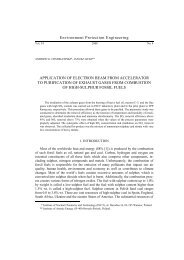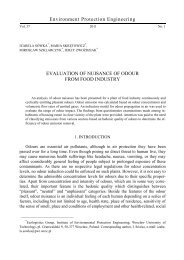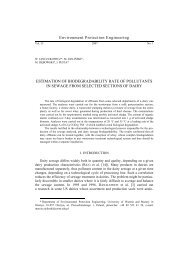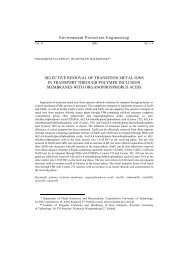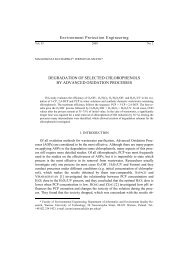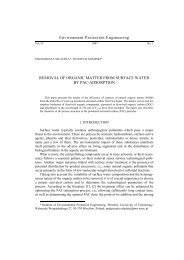Preliminary assessment of use of spider webs for the indication of air ...
Preliminary assessment of use of spider webs for the indication of air ...
Preliminary assessment of use of spider webs for the indication of air ...
Create successful ePaper yourself
Turn your PDF publications into a flip-book with our unique Google optimized e-Paper software.
180<br />
J. RYBAK et al.<br />
basic source <strong>of</strong> pollution with zinc [17]. However, it can also originate from corrode<br />
<strong>of</strong> building materials [18]. Differences in Zn, Pb and Pt content in <strong>webs</strong> compared<br />
with <strong>the</strong> results achieved by Hose et al. [13] could also be connected with <strong>the</strong> age <strong>of</strong><br />
studied <strong>webs</strong>. A choice <strong>of</strong> <strong>spider</strong> species <strong>for</strong> studies could be also important factor<br />
influencing results (Hose et al. [13] examined <strong>webs</strong> <strong>of</strong> species which are not recorded<br />
in Poland), thus such comparison could only give rough values.<br />
The emission deriving from transport decreased significantly since <strong>the</strong> introduction<br />
<strong>of</strong> lead-free petrol, however application <strong>of</strong> catalytic converters ca<strong>use</strong>s <strong>the</strong> emission<br />
<strong>of</strong> o<strong>the</strong>r harmful metal – platinum. Platinum is teratogenic (by damaging <strong>the</strong> foetus),<br />
is excreted with urine leading to kidneys injuries. Small amounts <strong>of</strong> platinum<br />
compounds are also strong allergens [3]. However, concentrations recorded in our<br />
studies are surprisingly high, posing a great threat to people and environment. The<br />
content <strong>of</strong> this element in <strong>spider</strong> silk has never been analysed, <strong>the</strong>re<strong>for</strong>e it is not possible<br />
to make any comparison. However, it is possible to compare <strong>the</strong> results <strong>of</strong> <strong>the</strong><br />
study with <strong>the</strong> concentrations recordec in dust collected in <strong>the</strong> vicinity <strong>of</strong> busy streets<br />
<strong>of</strong> Beijing. The obtained values were from 3.96 to 356.3 ng/g, however referential<br />
sites cumulated from 0.1 to 0.9 ng/g <strong>of</strong> Pt [18]. In our studies, site 2 achieved <strong>the</strong><br />
highest value (67 ng/g), site 1 was characterised by much lower value (27 ng/g) but<br />
not as low as got referential site in Beijing.<br />
Analyses per<strong>for</strong>med with <strong>the</strong> <strong>use</strong> <strong>of</strong> classic methods show that site 2 is generally<br />
characterised by higher level <strong>of</strong> <strong>air</strong> pollution (Fig. 1) and achieved values <strong>for</strong> Pb<br />
23 ng/m 3 and Zn 54 ng/m 3 . However, in <strong>the</strong> area <strong>of</strong> municipal background (site 1) contents<br />
<strong>of</strong> Pb were 13 ng/m 3 and Zn 27 ng/m 3 . When we compare <strong>the</strong> recorded concentrations<br />
<strong>of</strong> Pb and Zn in Wroclaw with literature data it can be concluded that <strong>the</strong>y fall<br />
within <strong>the</strong> range which was obtained in <strong>the</strong> world. Average concentration <strong>of</strong> Zn in <strong>the</strong><br />
atmosphere <strong>of</strong> urban agglomeration <strong>of</strong> Cincinnati, USA, obtained from a few measuring<br />
sessions, was 10–211 ng/m 3 depending on <strong>the</strong> season and location <strong>of</strong> measuring stations<br />
[19]. The highest values were recorded in <strong>the</strong> period from August to September in <strong>the</strong><br />
city centre. Pb concentrations were much lower, from 3 to 28 ng/m 3 . In Vienna (Austria)<br />
annual average values, in <strong>the</strong> municipal area, were Zn <strong>for</strong> and Pb from 22 to 17 <strong>of</strong><br />
ng/m 3 , however in <strong>the</strong> area located 30 km away from <strong>the</strong> city <strong>the</strong> values were lower,<br />
appropriately 17 and 12 ng/m 3 [20]. Next, in <strong>the</strong> fast developing cities <strong>of</strong> Asia concentrations<br />
<strong>of</strong> Zn and Pb were 245 and 79 ng/m 3 [21]. Never<strong>the</strong>less, it should be taken into<br />
account that annual values are always averaged from measurements conducted within<br />
a year and are usually lower than <strong>the</strong>se recorded at short periods <strong>of</strong> time.<br />
5. CONCLUSIONS<br />
The aim <strong>of</strong> our studies was a preliminary <strong>assessment</strong> <strong>of</strong> <strong>the</strong> possibilities <strong>of</strong> <strong>use</strong> <strong>of</strong><br />
<strong>spider</strong> <strong>webs</strong> <strong>for</strong> <strong>the</strong> <strong>indication</strong> <strong>of</strong> main <strong>air</strong> pollutants. The results <strong>of</strong> <strong>the</strong> study are prom-



